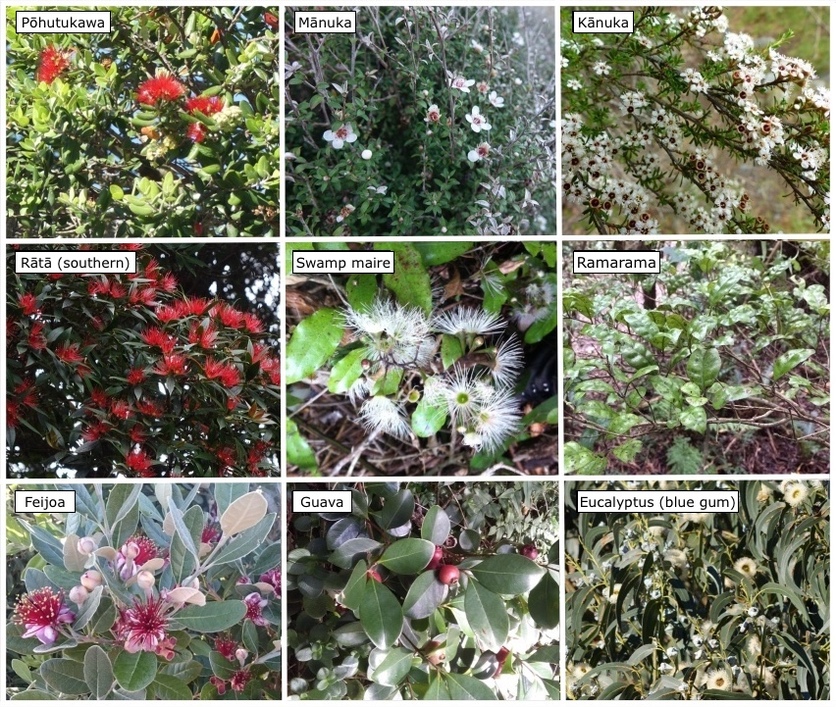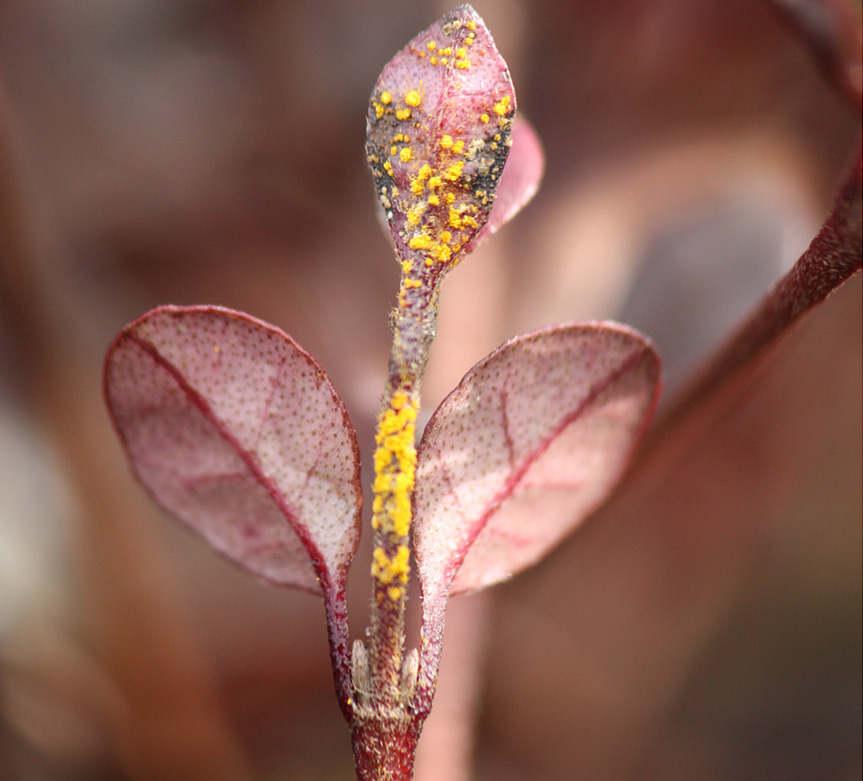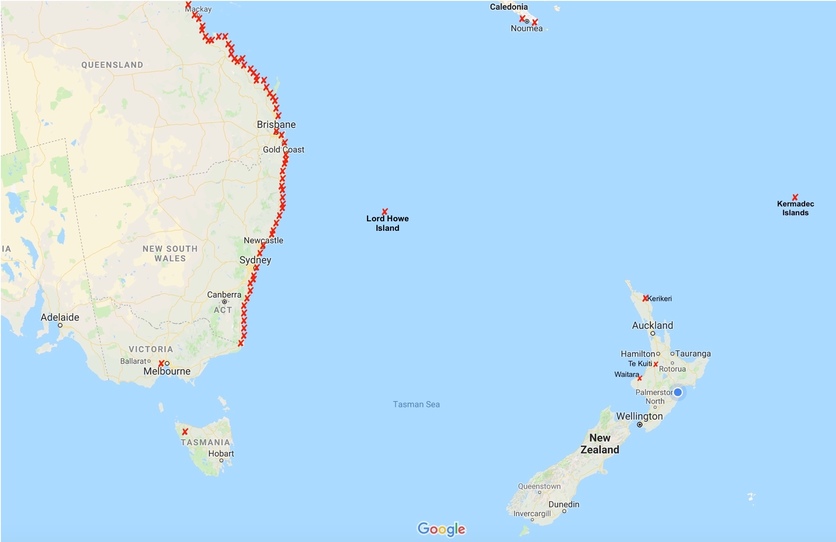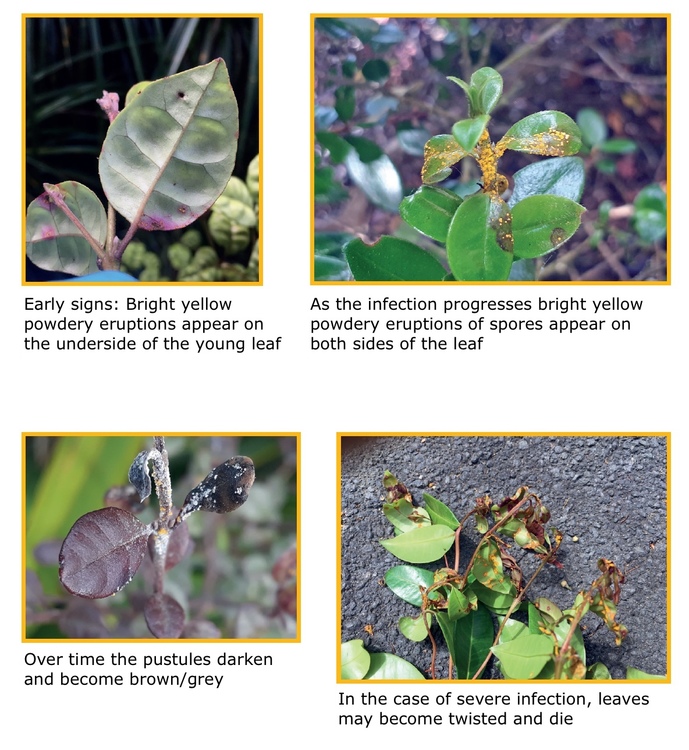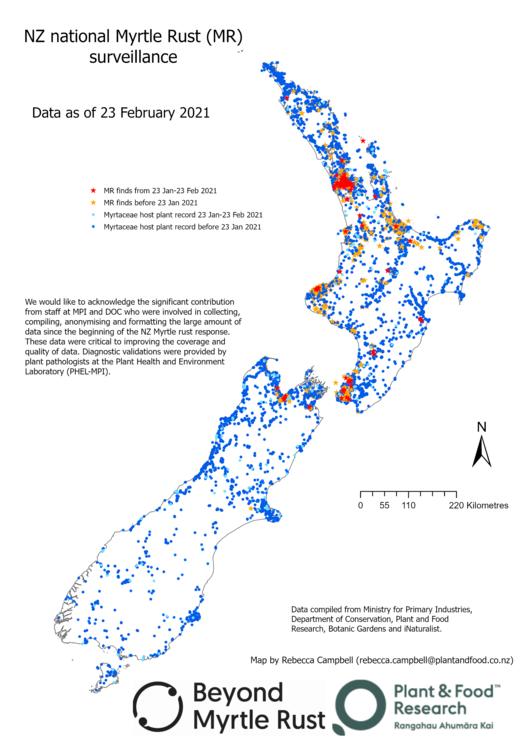Myrtle rust is a disease caused by the fungus Austropuccinia psidii. It threatens plants in the Myrtaceae (myrtle) family. New Zealand has a variety of native plants that belong to this family including pōhutukawa, mānuka, kānuka, rātā, swamp maire and ramarama. Other plants in the Myrtaceae family include the introduced fruit species feijoa and guava and commercially grown species such as eucalyptus.
The fungus harms the young, soft, actively growing parts of plants – leaves, shoot tips, buds, flowers and fruit – and it can affect seed development. Severe or repeated infections can kill the plants.
Symptoms
Myrtle rust thrives in warm temperatures with high humidity. It first appears in bright yellow, powdery eruptions on the underside of young leaves. As the infection grows, the yellow, powdery eruptions appear on both sides of the leaves. The pustules darken with time, and the leaves may become twisted and die.
Myrtle rust origins
The disease is native to Brazil, but it is found in many parts of the world. The fungal spores are microscopic and are easily dispersed by wind, insects and birds or by human activity. Myrtle rust was first detected in Australia in 2010. Initially, the Australian Government tried to contain the disease, but it quickly spread and became established along Australia’s east coast and then other parts of the country. As a result, the New Zealand Government banned imported flowers and foliage from Australian Myrtaceae family plants. Biosecurity officials began to develop a range of measures in case the disease spread to New Zealand.
A co-ordinated biosecurity response
The first New Zealand myrtle rust discovery was in April 2017 on Raoul Island in the Kermadec Islands. The find was concerning as it affects Kermadec pōhutukawa trees, but the island’s strictly controlled access and long distance from New Zealand meant that the rest of the country was temporarily protected.
Unfortunately, within a month, the situation had changed. On 3 May 2017, the Ministry for Primary Industries (MPI) received notification that five pōhutukawa seedlings in a Kerikeri nursery showed signs of myrtle rust. Laboratory testing confirmed the results, and MPI immediately put a restricted place notice in effect. The nursery plants were sprayed with fungicide, movement of plants and people on the site was restricted and work began to track any plants that had left the site. MPI staff checked properties surrounding the nursery for signs of the disease. It also set up field headquarters with the Department of Conservation (DOC) and consulted iwi, industry and the local council. MPI staff began checking 800 high-risk sites across the upper North Island while DOC initiated searches on conservation land.
A second infected site was found a few days later at a nearby property. MPI began producing daily media updates, and the public were encouraged to contact MPI’s exotic pest and disease hotline and photograph plants they suspected of having myrtle rust symptoms. The plan was to confine and eradicate the disease, if possible.
By mid-May 2017, several sites in the Taranaki region had confirmation of myrtle rust in commercial and private properties. Scientists suspected that the infections were being caused by wind-blown spores from Australia rather than the movement of plants within New Zealand. A further find in the Bay of Plenty a few weeks later supported the windborne infection theory. MPI continued to contain and destroy the infected plants in places where they were found.
When myrtle rust was first discovered on mainland New Zealand in May last year, we said it would be a challenging disease to contain and eradicate but we would give it a good crack.
Dr Catherine Duthie, Ministry for Primary Industries myrtle rust response spokesperson
A new approach
Less than a year after the disease was first found on mainland New Zealand, myrtle rust appeared in the South Island’s Tasman region. This indicated that the disease had reached most of the country’s high-risk regions. MPI is no longer involved in field work to manage the disease. MPI offers advice and guidance to landowners with myrtle rust on their properties but allows the landowners to manage the plants themselves. MPI is continuing to collect, analyse and report myrtle rust data.
MPI is also funding scientific research to better understand the disease and explore treatment and management options. Projects include monitoring natural ecosystems, research regarding tolerance and resistance of myrtle species and seed banking for the future.
What we know
By March 2019, 988 sites with myrtle rust had been identified. It appears that the most susceptible native myrtle species are ramarama, pōhutukawa and rātā. Mature ramarama tree deaths in the East Cape region were reported in 2020.
Fortunately, only low levels of infection have been detected in mānuka, kānuka and orchard plants like feijoa. New Zealand Plant Producers Incorporated provides protocols and advice for nurseries and other plant retailers.
MPI still encourages the public to be vigilant regarding myrtle rust. If you think you’ve seen myrtle rust, don’t touch it – take a photo and call 0800 80 99 66.
See the useful links section for more information about myrtle rust, how to identify it and sector advice.
Related content
The Hub's series of national myrtle rust surveillance maps ranges from October 2018 to February 2021. Use the maps to view the disease's spread and to compare data from month to month. The maps are an ideal way to practise the science capability 'Interpret representations'.
The Myrtle Rust Reporter is a citizen science project using iNaturalist to log sightings of the disease.
Australian scientists are investigating a biotechnology tool called RNA interference as a potential means of combating myrtle rust.
Seed banking is one tool being used to protect the Myrtaceae family.
The myrtle rust detection team uses PCR to identify myrtle rust spores. Find out about the PCR process in the article What is PCR?, which includes an animation that explains the three key steps involved in the PCR process.
Psa is another disease that has threatened New Zealand’s horticulture sector. Discover how scientists and industry worked to manage this disease in the article Kiwifruit – learning to live with Psa.
The Science Learning Hub team has curated a collection of resources with biosecurity as the context for learning. It includes suggestions on how to use images in this article to practise the science capabilities. We've also created a collection about forest health. Login to make either collection part of your private collection – just click on the copy icon. You can then add additional content, notes and make other changes. Registering an account for the Science Learning Hubs is easy and free – sign up with your email address or Google account. Look for the Sign in button at the top of each page.
Useful links
Myrtle rust in New Zealand hosts resources for identifying and managing myrtle rust including flyers, posters and other materials that can be printed or shared through social media.
Visit the Ministry for Primary Industries Biosecurity New Zealand website for information about myrtle rust. It includes symptoms to look out for, advice to specific groups and more.
In this YouTube video from the BioHeritage Challenge, Ngā Koiora Tuku Iko, listen to Roanne Sutherland from Scion talking about monitoring myrtle rust.
See the range of resources under the Myrtle ora topic on the New Zealand’s Biological Heritage – Ngā Koiora Tuku Iho website.
MPI has developed online training courses about myrtle rust. The courses are available to everyone but are particularly suited to those running community education events. Register for the course here. A selection of the training videos are found here.
See what the Department of Conservation is doing about myrtle rust.
The Department of Conservation has put restrictions on beehive movements on public conservation land.
The New Zealand Plant Producers Incorporated website has extensive industry advice concerning myrtle rust.
Read about the New Zealand Indigenous Flora Seed Bank project to collect seeds of both threatened and common species – including the Myrtaceae family. This DOC blog gives insight into how the Myrtaceae seeds are collected – it is an enormous task.
Hear from Ngāti Porou about what monitoring they've been doing, and what taonga could be at stake and hear about the community-focused approach they are calling for from government in this TVNZ 1News article with video included.
At the end of April 2021 it was announced that a successful trans-Tasman collaboration has enabled scientists to successfully sequence the genome of Austropuccinia psidii. Read the Landcare media release.
